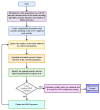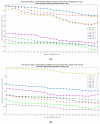Neuro-Particle Swarm Optimization Based In-Situ Prediction Model for Heavy Metals Concentration in Groundwater and Surface Water
- PMID: 35202281
- PMCID: PMC8879014
- DOI: 10.3390/toxics10020095
Neuro-Particle Swarm Optimization Based In-Situ Prediction Model for Heavy Metals Concentration in Groundwater and Surface Water
Abstract
Limited monitoring activities to assess data on heavy metal (HM) concentration contribute to worldwide concern for the environmental quality and the degree of toxicants in areas where there are elevated metals concentrations. Hence, this study used in-situ physicochemical parameters to the limited data on HM concentration in SW and GW. The site of the study was Marinduque Island Province in the Philippines, which experienced two mining disasters. Prediction model results showed that the SW models during the dry and wet seasons recorded a mean squared error (MSE) ranging from 6 × 10-7 to 0.070276. The GW models recorded a range from 5 × 10-8 to 0.045373, all of which were approaching the ideal MSE value of 0. Kling-Gupta efficiency values of developed models were all greater than 0.95. The developed neural network-particle swarm optimization (NN-PSO) models for SW and GW were compared to linear and support vector machine (SVM) models and previously published deterministic and artificial intelligence (AI) models. The findings indicated that the developed NN-PSO models are superior to the developed linear and SVM models, up to 1.60 and 1.40 times greater than the best model observed created by linear and SVM models for SW and GW, respectively. The developed models were also on par with previously published deterministic and AI-based models considering their prediction capability. Sensitivity analysis using Olden's connection weights approach showed that pH influenced the concentration of HM significantly. Established on the research findings, it can be stated that the NN-PSO is an effective and practical approach in the prediction of HM concentration in water resources that contributes a solution to the limited HM concentration monitored data.
Keywords: groundwater; heavy metals; neural network; particle swarm optimization; surface water.
Conflict of interest statement
The authors declare no conflict of interest.
Figures










































References
-
- Nem Singh J., Camba A. The role of domestic policy coalitions in extractive industries’ governance: Disentangling the politics of “responsible mining” in the Philippines. Environ. Policy Gov. 2020;30:239–251. doi: 10.1002/eet.1905. - DOI
-
- Obasi P.N., Akudinobi B.B. Potential health risk and levels of heavy metals in water resources of lead–zinc mining communities of Abakaliki, southeast Nigeria. Appl. Water Sci. 2020;10:184. doi: 10.1007/s13201-020-01233-z. - DOI
-
- Carvalho F.P. Mining industry and sustainable development: Time for change. Food Energy Secur. 2017;6:61–77. doi: 10.1002/fes3.109. - DOI
-
- Ali H., Khan E., Ilahi I. Environmental chemistry and ecotoxicology of hazardous heavy metals: Environmental persistence, toxicity, and bioaccumulation. J. Chem. 2019;2019:6730305. doi: 10.1155/2019/6730305. - DOI
Grants and funding
LinkOut - more resources
Full Text Sources

